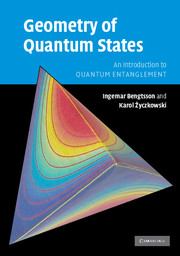Book contents
- Frontmatter
- Contents
- Preface
- 1 Convexity, colours and statistics
- 2 Geometry of probability distributions
- 3 Much ado about spheres
- 4 Complex projective spaces
- 5 Outline of quantum mechanics
- 6 Coherent states and group actions
- 7 The stellar representation
- 8 The space of density matrices
- 9 Purification of mixed quantum states
- 10 Quantum operations
- 11 Duality: maps versus states
- 12 Density matrices and entropies
- 13 Distinguishability measures
- 14 Monotone metrics and measures
- 15 Quantum entanglement
- Epilogue
- Appendix 1 Basic notions of differential geometry
- Appendix 2 Basic notions of group theory
- Appendix 3 Geometry: do it yourself
- Appendix 4 Hints and answers to the exercises
- References
- Index
1 - Convexity, colours and statistics
Published online by Cambridge University Press: 27 August 2009
- Frontmatter
- Contents
- Preface
- 1 Convexity, colours and statistics
- 2 Geometry of probability distributions
- 3 Much ado about spheres
- 4 Complex projective spaces
- 5 Outline of quantum mechanics
- 6 Coherent states and group actions
- 7 The stellar representation
- 8 The space of density matrices
- 9 Purification of mixed quantum states
- 10 Quantum operations
- 11 Duality: maps versus states
- 12 Density matrices and entropies
- 13 Distinguishability measures
- 14 Monotone metrics and measures
- 15 Quantum entanglement
- Epilogue
- Appendix 1 Basic notions of differential geometry
- Appendix 2 Basic notions of group theory
- Appendix 3 Geometry: do it yourself
- Appendix 4 Hints and answers to the exercises
- References
- Index
Summary
What picture does one see, looking at a physical theory from a distance, so that the details disappear? Since quantum mechanics is a statistical theory, the most universal picture which remains after the details are forgotten is that of a convex set.
Bogdan MielnikConvex sets
Our object is to understand the geometry of the set of all possible states of a quantum system that can occur in nature. This is a very general question, especially since we are not trying to define ‘state’ or ‘system’ very precisely. Indeed we will not even discuss whether the state is a property of a thing, or of the preparation of a thing, or of a belief about a thing. Nevertheless we can ask what kind of restrictions are needed on a set if it is going to serve as a space of states in the first place. There is a restriction that arises naturally both in quantum mechanics and in classical statistics: the set must be a convex set. The idea is that a convex set is a set such that one can form ‘mixtures’ of any pair of points in the set. This is, as we will see, how probability enters (although we are not trying to define ‘probability’ either). From a geometrical point of view a mixture of two states can be defined as a point on the segment of the straight line between the two points that represent the states that we want to mix. We insist that given two points belonging to the set of states, the straight line segment between them must belong to the set too. This is certainly not true of any set.
- Type
- Chapter
- Information
- Geometry of Quantum StatesAn Introduction to Quantum Entanglement, pp. 1 - 27Publisher: Cambridge University PressPrint publication year: 2006



